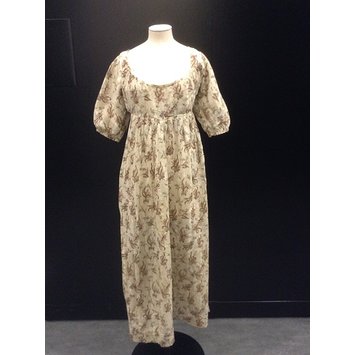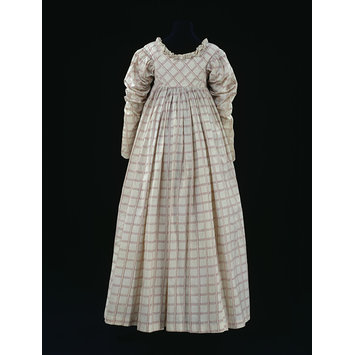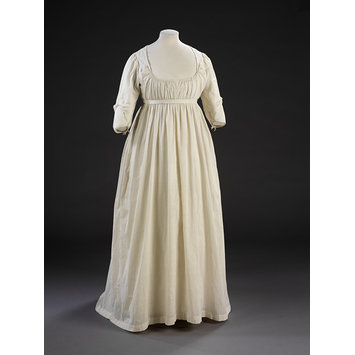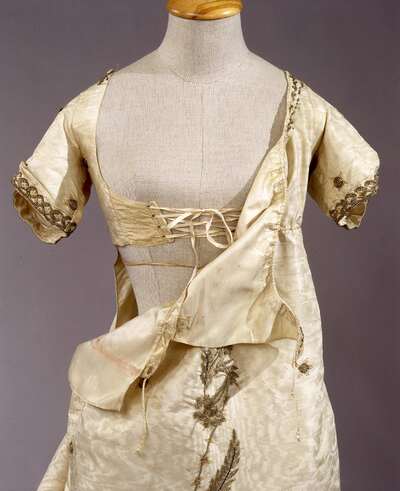 |
| Tools! |
Friday, August 30, 2019
Straw Plaiting Kit
Thursday, August 29, 2019
Wool Overshirt
From the Wambaugh, White & Co men's overshirt pattern. Square construction, went together easily, though I'm not sold on the placket construction.
 |
| Pretty decent buttonholes on this project. |
Saturday, August 24, 2019
NPS LGBTQ Interpretation Resource
Check out chapter 31 for Interpreting LGBTQ History; the rest of the project is also good reading.
Thursday, August 22, 2019
HFF 3.17: Harvest
The Challenge: Harvest. Make a food associated with harvest-time, try another way of preserving food, or make something seasonable for late summer.
The Recipe: Mint cakes from French Confectionery Adapted for English Families
MINT CAKES--Take some fresh leaves and chop them coarsel,y and put them in a saucepan with a cover, let it boil half an hour then squeeze it through a cloth, but not too hard; with this decoction moisten two pounds of flour, three quarters of a pound of sugar, a pound of fresh butter, and a little yeast; cut or rasp some candied citron, and add the yolks of four eggs; let it rise an hour in a warm place, then make the paste into cakes. They will be lighter without the butter. I think the flavour of mint is not generally liked; but give the receipt as a novelty for those who like variety in flavour. The cakes are very good for those who like the flavour of mint.
I chose this receipt because: 1) the mint plants in my garden are doing very, very well this year, and 2) the bolded bit about people not liking mint caught my eye.
The Date/Year and Region: London, 1853
How Did You Make It: I picked a generous handful of mint leaves, and boiled them for 30 minutes is about 2.5-3 cups of water. Working on a quarter scale, I mixed together 3 oz of granulated sugar, 8 oz of all-purpose flour, 1 tsp of dry yeast, 4 oz softened butter, and 1 egg. [The yeast quantity is a estimate based on the amount of flour and sugar used.] I strained the mint water, and added ~1.5 cups of it to the flour mixture, forming a sticky dough, rather thicker than a batter. I let this rise for 1 hour (in the oven on the 100F "bread proof" setting); I dropped the dough onto a paper-covered cookie sheet, forming cakes about half the size of my palm, and baked them for ~10 minutes at 350F. To the second pan, I added pieces of candied lemon peel, as I had no candied citron.
Time to Complete: Just under 2 hours, including rise time.
Total Cost: All ingredients on hand. Especially the mint.
How Successful Was It?: Unexpectedly pleasant. They're not quite sweet or savory, and the texture is somewhat between a cake and a soft roll, but it still somehow worked. I didn't notice the mint particularly in either variety. The cakes which had peel tasted just fine.
How Accurate Is It?: A lot of speculation went into this (amount of yeast, amount of liquid, amount of mint boiled in said liquid...). I also used active dry yeast instead of a period variety. The most noteworthy change was probably the lack of candied citron.
 |
| Mint Cakes. Some with candied peel, some without. |
Wednesday, August 21, 2019
Wimple Wednesday: Turban Cap, 1790s
After 4.5 months, the whole 'hand sew a new cap every week' business has finally gotten ahead of me. In order to keep up with my other projects, I'm going to start aiming for alternate Wednesdays on the millinery projects.
Part of the reason I missed last week was the 300+ inches of hemming on this 1790s 'turban cap'. The design is from The American Duchess Guide to 18th Century Dressmaking; it's a speculative reconstruction based on the turbans featured in Elizabeth Vigee Le Brun's portraiture.
 |
| The cap has promise. The hair needs a lot more curl. And maybe some hair powder... |
Monday, August 12, 2019
Original Empire Style Dresses
Sometimes, you start collecting images for a potential project, only to change course. Not entirely sure when I started this set, but enjoy:
And a nice insight into a front-fastening silk gown:
 |
| Cotton print day dress c.1800-1805, VAM. |
 |
| Neat bias bodice on this c.1814 day dress. VAM |
 |
| Delicious neo-classical gown, c.1797-1805 VAM |
 |
| Evening gown, Italian, c.1800-1825. Europeana Fashion Project |
Friday, August 9, 2019
Book Review: The Medieval Tailor's Assistant
I'm not sure how I missed writing this one up the first time around. Or last December when I otherwise cleared my book backlog. And now that I've made just about every hair covering in it, it's long past time for a review.
The Medieval Tailor's Assistant by Sarah Thursfield. Do check out the author's website: there are pretty pictures, as well as an explanation of the differences between the first and second editions of the book. The copy I'm reviewing is the 2012 printing of the first edition.
***
The book is subtitled "Making Common Garments 1200-1500", and what you see is what you get: men's, women's, and children's garments for a 300-year period covering the late middle ages. Accessories, undergarments, and outerwear are included--everything except shoes.
All of this is covered in ~220 pages, so efficiency is key. Construction techniques and fitting/block-making instructions are given at the outset (including 4 pages of illustrated handsewing stitches); consequently, the individual projects are handled with a line-drawing, a graphed cutting diagram, and a few sentences or short paragraphs about construction. Period materials are also discussed.
Note also, due to the long time frame, when each garment is appropriate (they are marked, and most of the period illustrations include a citation). Attempts are made to denote which garments are worn together and during what time frame. My favorite is the timeline on page 14 which shows approximate date ranges on the different garments. Featured garments include shirts/smocks, braes, hose, cotes, doublets, kirtles, surcoates, cotehardies, gowns, cloaks, hats, caps, head-dresses, and such accessories as bags, apron, mittens, and belts. Additionally, the chapter opening for each main garment (gowns, cotehardies) include line drawings of the relevant under- and over- layers for both men and women.
I have no real complaints about this book. The number of photographs is few, but the ones that are included are lovely (and the second edition has more!), while the line drawings are both plentiful and quite informative. If you like very detailed, incremental instructions, you may find this book a little daunting. Personally, I found it enjoyable to use: I love clear cutting diagrams.
Stars: 5
Accuracy: Good. The illustrations come from recognizable period images, but I could do with a couple more in-line citations.
Difficulty: Intermediate. The focus is on the cutting and assembly geometry, which I found easy to follow; the construction and stitches are much more straightforward than in some other periods. Persons who aren't comfortable with altering patterns and fitting may have difficulty.
Overall Impression: An easy-to-use, all-in-one guide to making medieval costumes along historic lines. Good for dressing men, women, and children from the skin out. You'll likely want to supplement with your own research (more about colors, material, context), but this books will be very helpful for figuring out how to render period images into garments. This is an excellent resource for costumers, designers, and cosplayers.
The Medieval Tailor's Assistant by Sarah Thursfield. Do check out the author's website: there are pretty pictures, as well as an explanation of the differences between the first and second editions of the book. The copy I'm reviewing is the 2012 printing of the first edition.
***
The book is subtitled "Making Common Garments 1200-1500", and what you see is what you get: men's, women's, and children's garments for a 300-year period covering the late middle ages. Accessories, undergarments, and outerwear are included--everything except shoes.
All of this is covered in ~220 pages, so efficiency is key. Construction techniques and fitting/block-making instructions are given at the outset (including 4 pages of illustrated handsewing stitches); consequently, the individual projects are handled with a line-drawing, a graphed cutting diagram, and a few sentences or short paragraphs about construction. Period materials are also discussed.
Note also, due to the long time frame, when each garment is appropriate (they are marked, and most of the period illustrations include a citation). Attempts are made to denote which garments are worn together and during what time frame. My favorite is the timeline on page 14 which shows approximate date ranges on the different garments. Featured garments include shirts/smocks, braes, hose, cotes, doublets, kirtles, surcoates, cotehardies, gowns, cloaks, hats, caps, head-dresses, and such accessories as bags, apron, mittens, and belts. Additionally, the chapter opening for each main garment (gowns, cotehardies) include line drawings of the relevant under- and over- layers for both men and women.
I have no real complaints about this book. The number of photographs is few, but the ones that are included are lovely (and the second edition has more!), while the line drawings are both plentiful and quite informative. If you like very detailed, incremental instructions, you may find this book a little daunting. Personally, I found it enjoyable to use: I love clear cutting diagrams.
Stars: 5
Accuracy: Good. The illustrations come from recognizable period images, but I could do with a couple more in-line citations.
Difficulty: Intermediate. The focus is on the cutting and assembly geometry, which I found easy to follow; the construction and stitches are much more straightforward than in some other periods. Persons who aren't comfortable with altering patterns and fitting may have difficulty.
Overall Impression: An easy-to-use, all-in-one guide to making medieval costumes along historic lines. Good for dressing men, women, and children from the skin out. You'll likely want to supplement with your own research (more about colors, material, context), but this books will be very helpful for figuring out how to render period images into garments. This is an excellent resource for costumers, designers, and cosplayers.
Wednesday, August 7, 2019
Wimple Wednesday: Elizabethan Hood With Bongrace
Back (once more) to the late 16th century. Cheating ever-so-slightly with a more structured indoor/outdoor headcovering: a hood. The brim is wired buckram, interlined with flannel (in place of the domette), covered in fine black wool, and lined with a scrap of white linen. The back bongrace is pinned up on the top-center of the brim. Design from The Tudor Tailor.
 |
| Still working out the hairstyle. I'm leaning towards the high back coil, but the coronet braids should have worked... |
Tuesday, August 6, 2019
HFF 3.16: Preserves
I feel a little bad for using a modern translation, and a lot bad for posting the challenge event late this fortnight. But I have been wanting to try these, I needed something from this time-frame for a recent event, and then I realized that I made a recipe using no less than three ingredients fitting the current challenge. So, I guess it balances out...
The Challenge: Preserves: Preserve seasonal produce, or make a dish which calls for preserved ingredients.
The Recipe: Ryschewys Close and Fryez
Take Fygys, & grynd hem smal in a mortere with a lytil Oyle,
& grynd with hym clowys & Maces; & þan take it vppe in-to
a vesselle, & cast þer-to Pynez, Saundrys, & Roysonys of Coraunce,
& mencyd Datys, Pouder Pepir, Canel, Salt, Safroun; þan take fyne
past of flowre an water, Sugre, Safroun, & Salt, & make fayre cakys
þer-of; þan rolle þin stuf in þin hond, & couche it in þe cakys, & kyt
it, & folde hym as Ruschewys, & frye hem vppe in Oyle; and serue
forth hote.
The Date/Year and Region: English, c.1430 [from the Harleian MS. 27, c.1430, printed by the Early English Text Society in 1888, with the modern translation from Historic Royal Palaces, c.2016]
How Did You Make It: I chopped up 9 dried figs and 6 dates, and mixed these with 3 Tbsp of dried currants. [At this point I should have added 1/2 tsp each of mace, black pepper, and cinnamon according to the modern recipe; possibly also cloves and saffron if I read the original correctly.]
I ground up a generous pinch of saffron stamens, and mixed them in 1 cup of water (turning it pale yellow), and then used it to make a paste with 1 3/4 cups white flour and 5 tsp sugar. I rolled this out on a pastry mat, cut it into ~2" circles with a biscuit cutter, added ~1 Tbsp of fruit filling to each circle, and folded the paste into half-circles. These were fried in lard until crispy and slightly-brown.
Time to Complete: About an hour to mix up the ingredients, and fry them in a deep pan.
Total Cost: Unsure, since I bought the ingredients at various times. The dried dates, figs, and currants are somewhat pricey in my part of the world, and the saffron is far from cheap.
How Successful Was It?: They taste nice: a little unusual to my palate, but interesting without being overwhelmingly weird. The figs and dates comprise the majority of the actual flavor; I barely noticed the sugar and saffron in the crust. I was worried about serving them cold (~8 hours after cooking), but they went over well at Faire. That being said, they definitely don't age well--I tried one couple days later and it was just sort of dull and chewy.
Interestingly, the fresh rhyschewys tasted fine even though they were much blander than they should have been. Honestly, I made a lot of mistakes here--I tripled the filling, but only doubled the crust (and somehow ended up with most crust than filling despite that), forgot all the spices, forgot the salt in the crust, and fried them wrong...and still ended up with an edible dish that I want to try again. The take away is that these just might be idiot-proof, and that I should never attempt to follow a recipe before 9am.
How Accurate Is It?: Aside from using the electric stove, the major issue was that I forgot to spice it. I also used lard to fry them--mostly because I got into a quandry about what sort of oil to use, and partly because I should not attempt to follow instructions quite so early in the morning.
Verdict: I like this, and will make them again (both because they were easy and well-received, and because I need to try it with the proper spices).
 |
| Rhyschemwys: 15th century fried fruit fritters. Delightful, despite me doing everything wrong with them. |
Sunday, August 4, 2019
Patchwork Kettle Holders
"Children may learn to make patch work by beginning with kettle holders and iron holders and for these purposes the smallest pieces of calico may be used. These holders should be lined with thick white muslin and bound all round with tape at one corner there should be a loop by which to hang them up. Blower holders are very convenient for the use of servants to save their hands from scorching when they remove the blower from the coal grate."
---Eliza Leslie's "The American Girl's Book", 1831/57, page 301
Thursday, August 1, 2019
Original: Silk Dress, c.1845
| Silk dress c.1845. From the Met. |
Long waist, heavily-gathered bodice, tight sleeves with faint echoes of the 1830s puffs. Not really my style, but it has its merits. And is that a shot silk I espy?
Subscribe to:
Comments (Atom)


